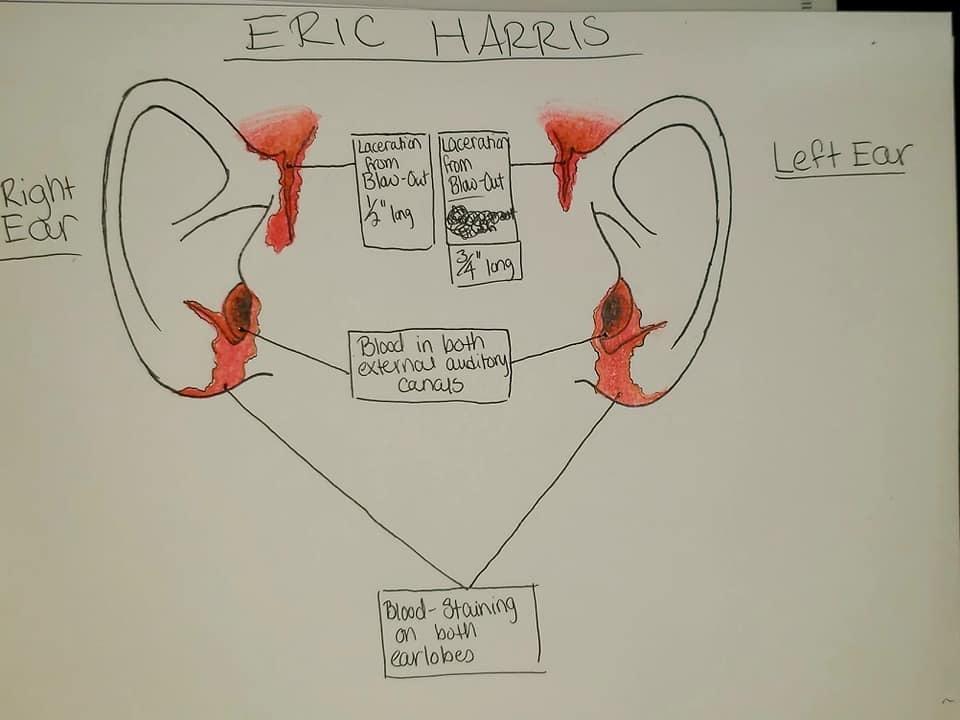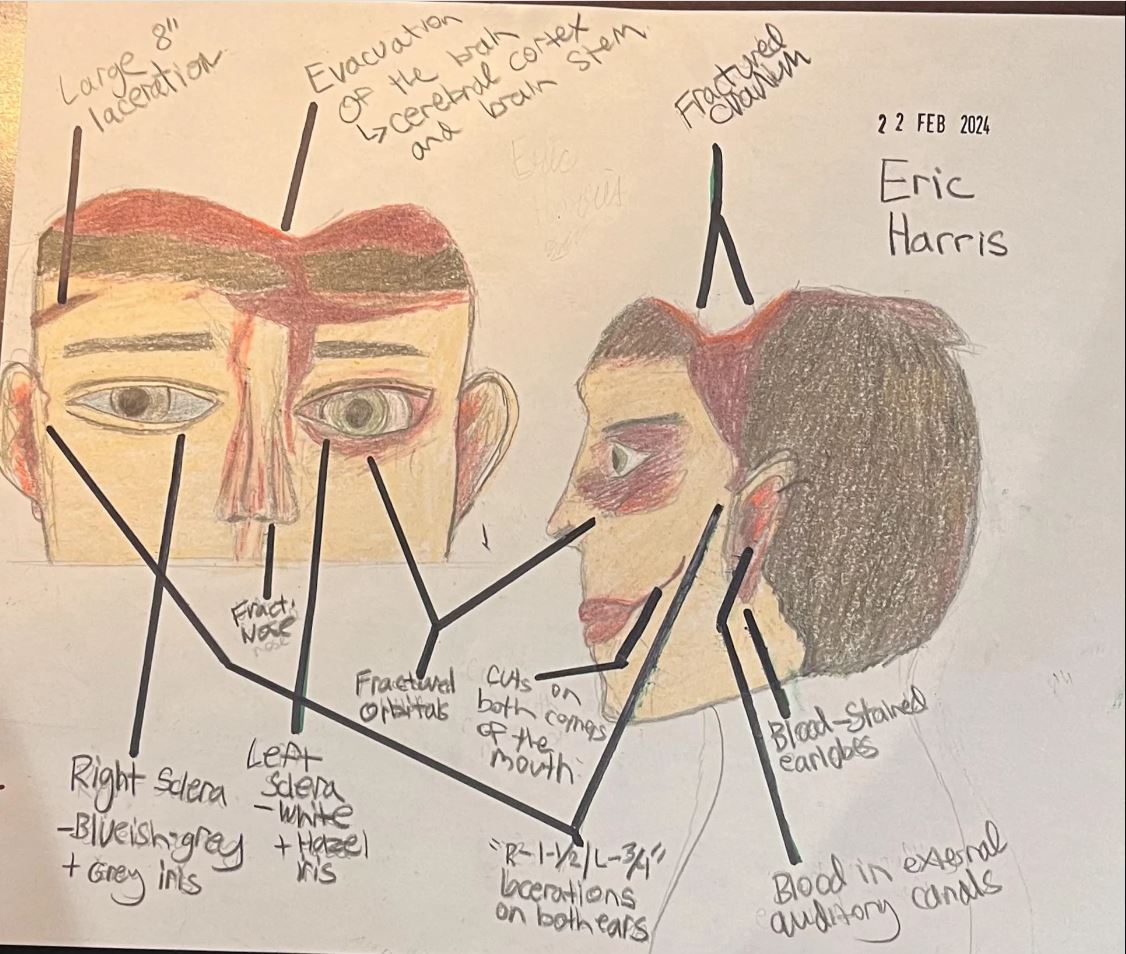Reveals Methamphetamine in Eric Harris’s Autopsy System
In a tragic unfolding of events in Tulsa, Oklahoma, the shooting death of Eric Harris autopsy has captured national attention, raising serious questions about police procedures and the use of volunteer deputies. The incident occurred during a sting operation on April 2, designed to apprehend individuals involved in illegal gun sales. Eric Harris, who was unarmed at the time, was fatally shot by Robert Bates, a 73-year-old volunteer sheriff’s deputy. Bates, a retired insurance executive who was serving on a violent crimes task force, has stated that he mistook his handgun for a Taser during the arrest attempt.
Following the shooting, an autopsy was conducted to determine the precise cause of death and to investigate other factors that might have influenced the incident’s outcome. The results, released on Tuesday, revealed high levels of methamphetamine in Harris’s system at the time of his death, alongside signs of acute intoxication by the drug. This discovery adds a complex layer to the case, considering the potential effects of methamphetamine on Harris’s behavior and state of mind during the confrontation.
The autopsy also noted that Harris suffered from cardiovascular disease and hypertension, which could have further complicated his physical condition during the altercation. With Bates charged with manslaughter and pleading not guilty, the case promises to navigate through intricate legal and ethical discussions. Moreover, Harris’s death has intensified the ongoing national debate over the appropriateness of police force, especially concerning the roles and training of volunteer officers in potentially volatile law enforcement situations.
| Event | Details |
|---|---|
| Location and Incident | Tulsa, Oklahoma – Eric Harris was fatally shot by Robert Bates, a 73-year-old volunteer sheriff’s deputy, during a sting operation on April 2 to catch individuals involved in illegal gun sales. |
| Cause of Incident | Bates, a retired insurance executive serving on a violent crimes task force, mistakenly used his handgun instead of a Taser. |
| Autopsy Findings | The autopsy revealed high levels of methamphetamine in Harris’s system, signs of acute intoxication, cardiovascular disease, and hypertension. |
| Legal Proceedings | Bates was charged with manslaughter and has pleaded not guilty. The case continues to navigate complex legal and ethical discussions. |
| Public Reaction and Debate | Harris’s death has heightened the national debate over the use of police force and the roles and training of volunteer officers. |
Contents
The Incident And Video
On April 2, in Tulsa, Oklahoma, a fatal shooting incident occurred involving Eric Harris, a suspect in an illegal gun-sale operation, and Robert Bates, a volunteer deputy. The incident began as a sting operation organized by the Tulsa County Sheriff’s Office aimed at cracking down on the illegal firearms market. Harris was targeted as a participant in this illicit trade.

The confrontation escalated when Harris, realizing he was under police surveillance, attempted to flee on foot. Bates, along with other officers, pursued Harris. During the chase, Bates, intending to incapacitate Harris non-lethally, reached for what he thought was his Taser. Tragically, he mistakenly drew his firearm instead and shot Harris once. The bullet struck Harris in the left armpit, leading to his immediate collapse and subsequent death at the scene.
Watch the video about Eric Harris’s Autopsy below:
Robert Bates, aged 73 at the time, was a retired insurance executive who had been volunteering with the sheriff’s office. His role as a volunteer deputy allowed him to participate in various tasks, including support in operations like the one that tragically ended Harris’s life. Bates had been authorized to carry a Taser and a firearm, though questions about his training and qualification for such a high-stakes role surfaced after the shooting. Bates maintained that the shooting was a grave mistake, resulting from his confusion in the heat of the moment.
| Event Description | Details |
|---|---|
| Date and Location | April 2, Tulsa, Oklahoma |
| Incident Overview | Eric Harris, a suspect in an illegal gun-sale operation, was fatally shot by Robert Bates, a volunteer deputy, during a sting operation by the Tulsa County Sheriff’s Office. |
| Confrontation Details | Harris attempted to flee on foot after realizing he was under surveillance. Bates, intending to use his Taser, mistakenly drew his firearm instead and shot Harris, leading to his immediate death. |
| Role and Background of Robert Bates | Bates, aged 73, a retired insurance executive and volunteer deputy, was involved in the operation. Questions arose about his training and qualifications following the incident. Bates claimed the shooting was an accidental result of confusion in the moment. |
Autopsy Findings
The autopsy conducted on Eric Harris revealed critical details that would contribute to understanding the full circumstances of his death. The report indicated high levels of methamphetamine in Harris’s system, a finding that was accompanied by the diagnosis of “acute intoxication by methamphetamine.” This level of drug presence suggested that Harris was significantly under the influence at the time of the incident.
Methamphetamine is a powerful central nervous system stimulant that can dramatically alter an individual’s behavior, potentially increasing their physical activity, anxiety, and susceptibility to erratic or violent actions. Such effects might have contributed to Harris’s decision to flee from deputies and could have influenced the deputies’ perception of the threat he posed during the chase.
Furthermore, the autopsy detailed other underlying health conditions such as cardiovascular disease and hypertension. These medical issues, when combined with high levels of methamphetamine, likely increased the risk of a fatal outcome from any physically stressful encounter, including being shot.

The bullet’s trajectory was another significant aspect of the autopsy. It entered Harris’s left armpit and traveled through his body, eventually lodging near his right armpit. This path indicated that Harris’s arms were likely raised or in motion, consistent with running or a confrontational posture at the time of the shot.
This combination of drug influence, underlying health conditions, and the manner in which the shooting occurred paints a complex picture of the tragic event. It raises profound questions about the appropriateness of the use of force and the challenges law enforcement officers face when making split-second decisions under stress. The findings from the autopsy not only provide insights into the immediate reasons for Harris’s death but also offer important data for ongoing discussions about law enforcement tactics, particularly concerning the deployment and control of volunteer deputies in critical and potentially lethal situations.
| Aspect | Details |
|---|---|
| Autopsy Findings on Drug Use | High levels of methamphetamine and diagnosis of “acute intoxication by methamphetamine” were found in Eric Harris’s system, indicating significant influence at the time of the incident. |
| Behavioral Impact of Methamphetamine | Methamphetamine, a powerful stimulant, could have increased Harris’s physical activity, anxiety, and propensity for erratic or violent actions, influencing his decision to flee and affecting deputies’ perception of him as a threat. |
| Health Conditions | Harris had underlying health issues such as cardiovascular disease and hypertension, which, combined with his drug use, increased the risk of a fatal outcome from the shooting. |
| Bullet Trajectory | The bullet entered Harris’s left armpit and traveled to near his right armpit, suggesting his arms were raised or in motion, indicative of running or a confrontational posture. |
| Implications and Discussion | The autopsy findings raise questions about the use of force and highlight the challenges faced by law enforcement in making split-second decisions under stress, contributing to discussions on law enforcement tactics and the role of volunteer deputies. |
Legal Proceedings
The legal repercussions for Robert Bates following the shooting of Eric Harris have been significant and complex. Bates was charged with second-degree manslaughter, which in Oklahoma is defined as a death caused by a person’s culpable negligence. Legally, this implies that Bates’s actions demonstrated a disregard for human life or an egregious lack of the caution that a reasonably careful person would exercise under similar circumstances. The charge is particularly pertinent given Bates’s confusion between his gun and Taser, suggesting a fatal lapse in the standard of care expected from someone in his position.
Following his arrest, Bates pleaded not guilty to the manslaughter charge. His defense largely hinges on the assertion that the shooting was an accident and not a result of reckless behavior, emphasizing the mistake of grabbing his firearm instead of his Taser as a momentary and tragic error rather than a negligent act. This plea sets the stage for a legal battle that explores the nuances of culpability in split-second law enforcement decisions.

The case proceedings have been closely watched, both locally and nationally, due to their implications for volunteer deputies’ roles in law enforcement. As of the latest updates, the trial has been scheduled, with both the prosecution and defense preparing to present evidence and arguments that will scrutinize Bates’s training, his decision-making during the incident, and the policies of the Tulsa County Sheriff’s Office. Legal experts anticipate motions from both sides addressing procedural and evidentiary issues, likely focusing on Bates’s qualifications and the sheriff’s office’s responsibility in the training and arming of volunteer deputies.
| Legal Aspect | Details |
|---|---|
| Charge | Robert Bates was charged with second-degree manslaughter in Oklahoma, which implies culpable negligence and a disregard for human life. |
| Defense Plea | Bates pleaded not guilty, arguing that the shooting was an accidental and not reckless behavior, emphasizing the mistake as a momentary error. |
| Legal Battle and Nuances | The case is set to explore nuances of culpability in law enforcement decisions, with a focus on whether the shooting was an accident or a result of negligence. |
| Case Proceedings | The trial is being closely watched, with both sides preparing to present evidence about Bates’s training, decision-making, and policies of the Tulsa County Sheriff’s Office. |
| Implications for Volunteer Deputies | The case has significant implications for the role and training of volunteer deputies, scrutinizing qualifications and responsibilities at a broader level. |
Broader Implications and Reactions
The shooting death of Eric Harris and the subsequent legal proceedings against Robert Bates have ignited a fiery debate over the use of force by law enforcement, particularly focusing on the role and regulation of volunteer deputies. Harris’s death has become a flashpoint in the broader national discourse concerning police accountability and the appropriate use of force, especially in contexts involving unarmed civilians.
In Tulsa and beyond, public protests have emerged in response to the incident, with demonstrators calling for a thorough examination of police practices and the use of volunteers in potentially lethal situations. These protests reflect a growing public demand for law enforcement reform, particularly in the training and deployment of non-regular officers in roles that carry significant risks of violent encounters.
The Tulsa County Sheriff’s Office has faced intense scrutiny and criticism over its policies. Statements from the office have defended Bates’s qualifications and the decision to involve him in the sting operation, yet the public and media backlash has prompted a reevaluation of policies concerning volunteer deputies. This scrutiny increased further following revelations that Bates’s training records might have been incomplete or inaccurately reported.
Officials, including Tulsa County District Attorney Stephen Kunzweiler, have weighed in on the case, often highlighting the need for systemic reforms in law enforcement training and oversight. These comments underscore the legal and ethical challenges facing the law enforcement community in balancing effective policing with the rights and safety of civilians.
The broader societal impact of Harris’s death and Bates’s trial resonates well beyond Tulsa, influencing national policies and debates about police practices. The case has also contributed to an ongoing reexamination of law enforcement’s role in community safety, the integration of volunteers into policing, and how these factors intersect with public perceptions of justice and accountability in the criminal justice system.
| Aspect | Details |
|---|---|
| Debate Focus | The shooting has sparked a debate on the use of force by law enforcement, particularly concerning the roles and regulations of volunteer deputies like Robert Bates. |
| Public Response | Public protests in Tulsa and elsewhere demand thorough examinations of police practices and the role of volunteers in critical situations, advocating for law enforcement reform. |
| Scrutiny of Tulsa Sheriff’s Office | Intense scrutiny and criticism have been directed at the Tulsa County Sheriff’s Office over its policies and Bates’s qualifications, especially after issues with his training records surfaced. |
| Official Statements and Reforms | Officials, including the District Attorney, have emphasized the need for systemic reforms in law enforcement training and oversight to balance policing with civilian rights and safety. |
| Societal and National Impact | The case has influenced national policies and debates on police practices, contributing to a reexamination of law enforcement’s role in community safety and public perceptions of justice. |
Controversies and Investigations
The shooting incident involving volunteer deputy Robert Bates has spurred extensive controversy, primarily centered around his qualifications and the adequacy of his training. Critics argue that Bates, a retired insurance executive without a professional law enforcement background, may not have been suitably trained for the high-stress, high-stakes scenarios that deputies regularly face. This concern was exacerbated by Bates’s admission that he mistook his firearm for a Taser, a mistake that points to potential gaps in his readiness and understanding of the equipment.
Further complicating the matter, an internal report surfaced suggesting that training records for Bates might have been modified or falsified. This revelation prompted an uproar over the integrity of the sheriff’s office’s training and oversight procedures. Questions arose about whether Bates was given preferential treatment due to his connections within the sheriff’s office, including his relationship with Tulsa County Sheriff Stanley Glanz, who described Bates as a friend.
The internal report, obtained by NBC News, indicated that at least three of Bates’s training certificates were signed off by officers who later denied having done so. This discovery led to widespread skepticism and distrust towards the sheriff’s office’s transparency and accountability. In response, Tulsa County District Attorney Stephen Kunzweiler called for a deeper investigation into the matter, underscoring the need for thorough scrutiny and accountability in law enforcement training practices, particularly regarding volunteer deputies.
| Topic | Details |
|---|---|
| Controversy Focus | The controversy centers on Robert Bates’s qualifications and the adequacy of his training as a volunteer deputy, particularly after he mistook his firearm for a Taser. |
| Training Record Issues | An internal report suggested that Bates’s training records might have been modified or falsified, raising concerns about the integrity of the sheriff’s office’s training procedures. |
| Preferential Treatment Concerns | Questions about whether Bates received preferential treatment due to his connections within the sheriff’s office, including his relationship with Sheriff Stanley Glanz. |
| Training Certificate Discrepancies | The report indicated that some of Bates’s training certificates were signed off by officers who later denied having done so, leading to skepticism and distrust towards the sheriff’s office. |
| Call for Investigation | Tulsa County District Attorney Stephen Kunzweiler called for a deeper investigation into the training and oversight of volunteer deputies, highlighting the need for accountability. |
This case encapsulates multiple critical issues at the heart of law enforcement in America today. The tragic death of Eric Harris at the hands of a volunteer deputy with questionable qualifications and potentially falsified training records has ignited debates and discussions about police practices, accountability, and the role of non-professional volunteers in policing. These discussions are not just confined to Tulsa but resonate across the nation as communities and law enforcement agencies grapple with similar challenges.
Immediately refer to the following pdf file about Eric Harris’s Autopsy:eric harris autopsy
The legal battle involving Robert Bates, coupled with the public outcry and the internal investigations, illustrates the complexities of ensuring adequate training and oversight in law enforcement. This incident has revealed potential vulnerabilities in the system that could endanger public safety and undermine trust in the police force. The controversies surrounding Bates’s qualifications and the subsequent investigations into the sheriff’s office practices highlight a significant need for reforms in how volunteer deputies are integrated and supervised.
Reflecting on the broader societal implications, this case serves as a pivotal example of the ongoing debate over police practices and accountability. It raises important questions about who is allowed to wield police powers and under what conditions, the extent to which personal relationships influence professional responsibilities, and how to balance the need for additional law enforcement personnel with the imperative of maintaining high training and performance standards.
Ultimately, the shooting of Eric Harris and the fallout it caused is a stark reminder of the need for continual assessment and reform of policing standards. It underscores the importance of transparency, rigorous training, and clear accountability mechanisms in law enforcement to foster trust and ensure the safety of both officers and the communities they serve. As society moves forward, these incidents serve as critical junctures for reflection and potential recalibration of law enforcement policies and practices, aiming to enhance the efficacy, fairness, and integrity of policing nationwide.
Global News -The Controversial Death of Pat Tillman Autopsy Suspicions
Lone Survivor of the Paria Fuel Incident
The Truman Doctrine Shaping U.S. Foreign Policy in 1947
Ahead of NFL Draft Denver Broncos New Uniforms Leaked
Basketball Stars Paige Bueckers and Kamilla Cardoso
Uniform Unveiling amidst Dallas Cowboys Trade Rumors
Kenley Pope Rising Star in Competitive Cheerleading
